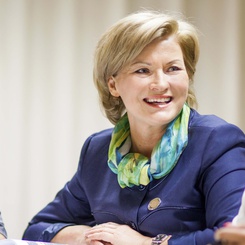With Stefan Gröschl and Junko Takagi
Though times of crisis might induce companies to entrench themselves in the old tried and true ways of doing business, ESSEC’s Stefan Gröschl and Junko Takagi would argue that our current slump is a call for change.
“Overcoming challenges like we see today is really about asking questions, looking at complex issues from a more holistic perspective, finding new ways of tackling old problems,” explains Professor Gröschl. “Doing this requires diversity. It requires individuals who can look at problems from different angles, bring new perspectives and really look at the bigger picture.”
Admittedly, with limited team diversity an organization might solve a given problem. However, a homogeneous team encourages a collective mindset that reduces the number of solutions a team can propose. Businesses are beginning to understand that there are many different ways of solving a single problem. A more diverse team might be in a better position to think outside the box and come up with more innovative solutions that would foster better results. At the same time, understanding a phenomenon conceptually is easier than acting upon new ideas.
Professor Takagi likes to look at diversity as a potential source of what she calls cognitive flexibility. “Cognitive flexibility is thinking differently about problems. Businesses can tackle challenges in more than one way, they have choices. When these choices lead to exchanges between a diverse group of individuals, it can open more windows of opportunity.”
The first steps for creating more diversity within an organization?
If diversity fosters innovative thinking and cognitive flexibility within organizations, how can companies encourage a cultural evolution within their business? A first and crucial step to implementing a strategy for diversity is learning to recognize it – or a lack thereof – in all its forms. As the word itself implies, this is a multifaceted concept. In the context of organizational management, it encompasses all kinds of perceivable differences between individuals including gender, culture, age, physical abilities, professional training and academic background.
What’s more, diversity is a complex notion in that it touches on all functions within an organization. “Diversity is everywhere and it touches on everything including functions such as purchasing, product development and other fundamental activities of organizations that might not normally be considered as areas where diversity can play a role.”
Diversity is about more than just quotas
To put the notion in simpler terms, Professor Takagi adds: “to pare it down, diversity is difference. And in particular, differences that we tend to ignore.” Where some might talk of gender discrimination no longer being an issue, or a met quota meaning successful corporate diversification, this is a sure sign that a deeper problem is being ignored.
At the end of the day, it’s not just about numbers. To name just one striking example to illustrate this point, Professor Takagi mentions Norway, a country which established a 40% gender diversity quota requirement for companies almost a decade ago. On average, Norwegian companies have today met this demand. So in terms of numbers, the quota has been met. Has that resolved the issues for gender diversity? Not necessarily.
“You’ve got to look at where these women have come from. How are they perceived by others in the firm?” she asks. “It’s also about how individuals within the company have understood the phenomenon. Not only how female populations will be impacted, but also how the men in the firm will interpret the change. This is the kind of situation where you need cognitive flexibility or changes in perception. Otherwise, outsiders continue to be seen as token and as different and there is no substantial impact.”
Although she doesn’t feel comfortable with the notion of inclusion or exclusion “because it identifies this kind of barrier between them and us,” Professor Takagi adds that a program of integration is essential.
According to Professor Gröschl, companies that are looking to create better integration and add value through collaboration between diverse teams need to have a strategy. “If these initiatives aren’t thought through, rather than create solidarity, they can create competition between conflicting interest groups,” he explains. “If a minority network’s role is to improve their own position within the organization, you’re not achieving an integrated culture, you’re in fact creating different interest groups that do not contribute to the overall success of the company or business objectives.”
“To name just one example of successful implementation, in the 1990’s IBM looked at creating networks for their various minority groups – including women and individuals with physical disabilities for example – and focused on finding ways to let these groups use their particular knowledge and experiences to achieve overall business goals. The individuals with physical disabilities gave IBM special insight when creating accessibility standards, which helped the company stay ahead of the curve in this area. Women lent an interesting perspective to entrepreneurship, especially since many entrepreneurs are women and ethnic minority groups.”
Creating an environment of cooperation, where individuals can be proactive, is key to fostering innovative thinking within diverse organizations. Ultimately, this creativity and innovation helps respond to new market demands more proactively and can ultimately impact your bottom line.
Recruitment strategies need to be revisited
Clearly, creating a more diverse workforce starts with a recruitment strategy. And it’s not only about creating a culturally diverse workforce – it’s also important to create a diverse mindset. As professor Takagi explains, “In this notion of efficiency upheld by many businesses, hiring graduates from a handful of schools, from a handful of academic disciplines, is a model that has worked well in the past. But this way of operating doesn’t create new outlooks on problems.The crisis is showing us that it’s time to look for other ways and diversity can be a trigger for finding new ways of looking at a problem.”
Professor Gröschl adds that French companies in particular have maintained a focus on the educational background of their recruits. “This system – where if you study business, you work in business; if you study liberal arts, you work in liberal arts – creates a very pragmatic, sectorial and rigid job market. Not only does it become very difficult for people to move around in their career, it has also created a real lack of diversity within some of the top French businesses.”
“With the kind of a common mindset created by traditional recruitment strategies, you reduce your team’s ability to question the current practices and routines. ESSEC Professor Laurent Bibard would call this the silencing of the organization.”
Indeed, the challenges we face today require interdisciplinary and holistic understanding to foster effective responses. “Businesses need to revisit their recruitment strategies and more actively look to hire individuals coming from disciplines that are not traditionally considered – like liberal arts, philosophy, psychology etc.,” suggests professor Gröschl. “These disciplines teach students to ask questions. This type of recruitment is a system that has already been successfully tested in Anglo-Saxon countries.”
Responsible leadership – “doing well” and “doing good”
To accommodate a diverse workforce, you need a cultural change. To do this, businesses need to go beyond the notion of diversity and explore new paradigms of leadership.
“Ultimately, businesses need to create responsible leaders,” explains Professor Gröschl. “This is leadership that wants to do well in terms of the bottom line, but also wants to do good. Leadership that aims to maximize profit as a means rather than as a goal.”
However, he goes on to say that what has been done to date to foster responsible leadership has been rather embryonic. At the end of the day, corporate social responsibility initiatives and diversity programs have been mainly driven by a HR department, while business leaders are first and foremost looking at profit maximization and shareholder value. Globally addressing the complex issues we are facing needs some kind of collective response. Today’s crisis is a call for more responsible leadership that uses this profit maximization not as the goal but as the vehicle to reach other goals.
“However, if you want to ensure that a diversity strategy is successful, corporate leadership must be on board,” he explains. “The CEO is the one who is going to have to sell any kind of socially responsible initiative, including diversity. If you’re working strictly from an HR perspective, you’re not going to succeed. You need to be clear about why you do it and how you do it and communicate that right to the bottom.”
Professor Takagi adds to this a need for an evolution in corporate culture: “companies need to bring this kind of responsibility into their daily practices in order to contribute not only to the bottom line of the organization, but also to a larger societal evolution.”
“L’Oreal, for example – a chair partner we work with and a firm with which I am familiar – came to realize that their policy of solidarity sourcing, ensuring diversity of suppliers, had aspects of diversity,” explains Professor Takagi. “So what I really like here is that it didn’t start with diversity, it started with something else. But in order to do that something else, L’Oreal needed to go through this notion of diversity. This notion has become a part of their culture.”
Today, the reality is that many companies aren’t thinking this way yet. That said, the bottom line is still the bottom line and companies must maintain competitiveness. With the objective of impacting their bottom line, companies should give themselves space to consider alternatives and push established corporate culture to evolve.
In a sense, ESSEC’s Leadership and Diversity Chair acts as a motor to encourage this notion of cognitive flexibility within organizations. As Professor Takagi explains, “our role is to propose alternatives. Through our research, we have more liberty, time and space to be reflexive on these issues than do managers. They support us in order to give this kind of reflection room to grow.”









